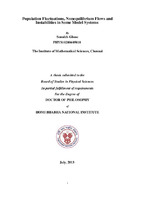- DSpace Home
- →
- IMSc Theses/ Dissertations
- →
- IMSc Theses/ Dissertations
- →
- View Item
JavaScript is disabled for your browser. Some features of this site may not work without it.
| dc.contributor.author | Somdeb Ghose | |
| dc.date.accessioned | 2014-07-04T05:19:00Z | |
| dc.date.available | 2014-07-04T05:19:00Z | |
| dc.date.issued | 2014 | |
| dc.date.submitted | 2014 | |
| dc.identifier.uri | https://dspace.imsc.res.in/xmlui/handle/123456789/354 | |
| dc.description.abstract | Living entities perpetually exist away from equilibrium, a condition necessary for the proper functioning of crucial biological and biochemical processes. Tools from nonequilibrium physics are thus ideally suited to the study of such systems. This thesis, studies nonequilibrium effects in a variety of model systems. The first part of the thesis, focus on counterintuitive effects of intrinsic noise as a result of fluctuations in finite-sized populations. It is found that, at the macroscale, intrinsic noise can generate and sustain oscillations in a model of epidemic spreading. At the microscale, intracellular biochemical reactions catalyzed by mesoscopic concentrations of enzymes exhibit phenomena that qualitatively differ from those due to a single enzyme or a deterministically large concentration of the same. The second part of the thesis, studies the dynamics of microscopic particles in a viscous fluid that are autonomously motile due to the conversion of chemical energy to mechanical motion. Momentum conservation and the lack of inertia at the microscale ensure that the flows around such chemomechanically active particles are force-free and torquefree. This study presents an intuitive analytical method to study such active flows in terms of its fundamental irreducible components and to reconstruct essential features of flows around various swimming microorganisms using these “atomic” flows. Filaments constructed using a collection of such active particles, interacting through local elastic potentials and nonlocal hydrodynamics, show instabilities that develop into complex flow patterns and result in complicated translational and rotational motions. Stability analysis reveals that hydrodynamic interactions are crucial for the development of such instabilities. This thesis describes these in greater detail. | en_US |
| dc.publisher.publisher | The Institute of Mathematical Sciences | |
| dc.subject | Nonequilibrium Flows | en_US |
| dc.subject | Stability Analysis | en_US |
| dc.subject | BioChemical Processes | en_US |
| dc.subject | HydroDynamic Interactions | en_US |
| dc.subject | HBNI Th70 | en_US |
| dc.title | Population Fluctuations, Nonequilibrium Flows and Instabilities in Some Model Systems[HBNI Th70] | en_US |
| dc.type.degree | Ph.D | en_US |
| dc.type.institution | HBNI | en_US |
| dc.description.advisor | Ronojoy Adhikari | |
| dc.description.pages | 136p. | en_US |
| dc.type.mainsub | Physics | en_US |
| dc.type.hbnibos | Physical Sciences |
Files in this item
This item appears in the following Collection(s)
-
IMSc Theses/ Dissertations
IMSc Theses/ Dissertations
